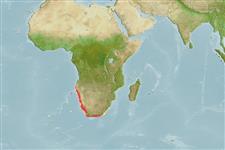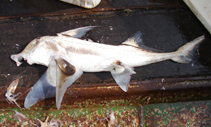Callorhinchus capensis Duméril, 1865
Cape elephantfish
Ajouter votre observation dans Fish Watcher
| Native range | All suitable habitat | Point map | Year 2050 |

|
| This map was computer-generated and has not yet been reviewed. |
| Callorhinchus capensis AquaMaps Data sources: GBIF OBIS |
Envoyez vos Photos et vidéos
Pictures | Images GoogleCallorhinchus capensis
Picture by Le Noury, P.
Pictures | Images GoogleCallorhinchus capensis
Picture by Le Noury, P.
Namibia country information
Common names:
Josef, Josefvis, St. Joseph
Occurrence: native
Salinity: marine
Abundance: abundant (always seen in some numbers) | Ref: Compagno, L.J.V., D.A. Ebert and M.J. Smale, 1989
Importance: of no interest | Ref: Okeyo, D.O., 2005
Aquaculture: | Ref:
Regulations: | Ref:
Uses: live export: yes;
Comments: Abundant off the coast. Caught with bottom trawls and commonly by shore anglers (Ref. 36731). Also Ref. 3180, 5578, 7403, 12484, 54854, 58304.
National Checklist:
Country Information: https://www.cia.gov/library/publications/resources/the-world-factbook/geos/wa.html
National Fisheries Authority: http://www.benefit.org.na/
Occurrences: Occurrences Point map
Main Ref: Bianchi, G., K.E. Carpenter, J.-P. Roux, F.J. Molloy, D. Boyer and H.J. Boyer, 1999
National Database:
Occurrence: native
Salinity: marine
Abundance: abundant (always seen in some numbers) | Ref: Compagno, L.J.V., D.A. Ebert and M.J. Smale, 1989
Importance: of no interest | Ref: Okeyo, D.O., 2005
Aquaculture: | Ref:
Regulations: | Ref:
Uses: live export: yes;
Comments: Abundant off the coast. Caught with bottom trawls and commonly by shore anglers (Ref. 36731). Also Ref. 3180, 5578, 7403, 12484, 54854, 58304.
National Checklist:
Country Information: https://www.cia.gov/library/publications/resources/the-world-factbook/geos/wa.html
National Fisheries Authority: http://www.benefit.org.na/
Occurrences: Occurrences Point map
Main Ref: Bianchi, G., K.E. Carpenter, J.-P. Roux, F.J. Molloy, D. Boyer and H.J. Boyer, 1999
National Database:
Common names from other countries
Classification / Names Noms communs | Synonymes | Catalog of Fishes(Genre, Espèce) | ITIS | CoL | WoRMS | Cloffa
Holocéphales (chimères) (chimaeras) > Chimaeriformes (Chimaeras) > Callorhinchidae (Plownose chimaeras)
Etymology: Callorhinchus: Tautonymous with Chimaera callorynchus Linnaeus 1758 (but unnecessarily emended from -rynchus to -rhinchus: callum (L.), hard skin; rhynchus (L.), snout, referring to peculiar hoe-shaped proboscis (See ETYFish); capensis: -ensis, Latin suffix denoting place: Cape of Good Hope, type locality (See ETYFish).
More on author: Duméril.
Etymology: Callorhinchus: Tautonymous with Chimaera callorynchus Linnaeus 1758 (but unnecessarily emended from -rynchus to -rhinchus: callum (L.), hard skin; rhynchus (L.), snout, referring to peculiar hoe-shaped proboscis (See ETYFish); capensis: -ensis, Latin suffix denoting place: Cape of Good Hope, type locality (See ETYFish).
More on author: Duméril.
Issue
Needs revision.
Environment: milieu / climate zone / depth range / distribution range Écologie
marin démersal; profondeur 10 - 374 m (Ref. 5578), usually 10 - 200 m (Ref. 3180). Subtropical; 17°S - 35°S, 11°E - 34°E
Distribution Pays | Zones FAO | Écosystèmes | Occurrences | Point map | Introductions | Faunafri
Length at first maturity / Taille / Poids / Âge
Maturity: Lm 49.6 range ? - ? cm
Max length : 122 cm TL mâle / non sexé; (Ref. 3180); poids max. publié: 5.3 kg (Ref. 40637)
Max length : 122 cm TL mâle / non sexé; (Ref. 3180); poids max. publié: 5.3 kg (Ref. 40637)
Description synthétique Clés d'identification | Morphologie | Morphométrie
Épines dorsales (Total) : 1. An elephant fish with a hoe-like snout and arched caudal fin (Ref. 5578). Silvery or bronzy with brown markings on flanks and head; fin webs brown (Ref. 5578).
Found from close inshore and shallow bays to the slope (Ref. 5578). Feeds on small fish and a wide variety of invertebrates (Ref. 27121). Oviparous (Ref. 50449). Produces egg-cases that are spindle shaped, with broad horizontal flanges (Ref. 36731). This species is known to host on its gills monogenean parasites Callorhynchocotyle callorhynchi (Manter, 1955) (Hexabothriidae) and Callorhynchicola multitesticulatus Manter, 1955 (Chimaericolidae) on its gills (Ref. 124045, 124046). Sold commercially as 'silver trumpeter' (Ref. 3180) and considered a delicacy in southern Africa (Ref. 27121). Minimum depth reported from Ref. 7403.
Life cycle and mating behavior Maturité | Reproduction | Frai | Œufs | Fécondité | Larves
Oviparous (Ref. 50449).
Référence principale
Upload your references | Références | Coordinateur | Collaborateurs
Krefft, G., 1990. Callorynchidae. p. 117. In J.C. Quero, J.C. Hureau, C. Karrer, A. Post and L. Saldanha (eds.) Check-list of the fishes of the eastern tropical Atlantic (CLOFETA). JNICT, Lisbon; SEI, Paris; and UNESCO, Parisl. Vol. 1. (Ref. 7403)
Statut dans la liste rouge de l'IUCN (Ref. 130435: Version 2024-2)
Préoccupation mineure (LC) ; Date assessed: 02 September 2019
Utilisations par l'homme
Pêcheries: intérêt commercial mineur; pêche sportive: oui
FAO(pêcheries: production; publication : search) | FIRMS (Stock assessments) | FishSource | Sea Around Us
Plus d'informations
Trophic ecology
Éléments du régime alimentaire
Composition du régime alimentaire
Consommation alimentaire
Food rations
Prédateurs
Éléments du régime alimentaire
Composition du régime alimentaire
Consommation alimentaire
Food rations
Prédateurs
Population dynamics
Paramètres de croissance
Max. ages / sizes
Length-weight rel.
Length-length rel.
Fréquences de longueurs
Mass conversion
Recrutement
Abondance
Paramètres de croissance
Max. ages / sizes
Length-weight rel.
Length-length rel.
Fréquences de longueurs
Mass conversion
Recrutement
Abondance
Life cycle
Reproduction
Maturité
Fécondité
Frai
Spawning aggregations
Œufs
Développement de l'œuf
Larves
Dynamique des populations larvaires
Reproduction
Maturité
Fécondité
Frai
Spawning aggregations
Œufs
Développement de l'œuf
Larves
Dynamique des populations larvaires
Anatomy
Surface branchiale
Brain
Otolith
Surface branchiale
Brain
Otolith
Physiology
Body composition
Nutrients
Consommation d'oxygène
Type de nage
Vitesse de nage
Visual pigments
Fish sound
Diseases & Parasites
Toxicity (LC50s)
Body composition
Nutrients
Consommation d'oxygène
Type de nage
Vitesse de nage
Visual pigments
Fish sound
Diseases & Parasites
Toxicity (LC50s)
Genetics
Génétique
Heterozygosity
Héritabilité
Génétique
Heterozygosity
Héritabilité
Human related
Aquaculture systems
Profils d'aquaculture
Souches
Ciguatera cases
Stamps, coins, misc.
Aquaculture systems
Profils d'aquaculture
Souches
Ciguatera cases
Stamps, coins, misc.
Outils
E-book | Guide de terrain | Générateur de fréquences de longueur | Outil de dynamique de population | Carte par point | Classification Tree
| Catch-MSY |
Articles particuliers
Télécharger en XML
Sources Internet
Aquatic Commons | BHL | Cloffa | Websites from users | FishWatcher | CISTI | Catalog of Fishes(Genre, Espèce) | DiscoverLife | ECOTOX | Faunafri | Fishtrace | GenBank(génôme, nucléotide) | GloBI | GOBASE | | Google Books | Google Scholar | Google | IGFA World Record | MitoFish | Otolith Atlas of Taiwan Fishes | PubMed | Reef Life Survey | Scirus | SeaLifeBase | Arbre de Vie | Wikipedia(aller à, chercher) | World Records Freshwater Fishing | Zoological Record
Estimates based on models
Preferred temperature (Ref. 115969): 10.3 - 21, mean 16.2 (based on 200 cells).
Phylogenetic diversity index (Ref. 82804): PD50 = 0.7500 [Uniqueness, from 0.5 = low to 2.0 = high].
Bayesian length-weight: a=0.00389 (0.00180 - 0.00842), b=3.12 (2.94 - 3.30), in cm Total Length, based on all LWR estimates for this body shape (Ref. 93245).
Niveau trophique (Ref. 69278): 3.5 ±0.52 se; based on food items.
Résilience (Ref. 120179): Faible, temps minimum de doublement de population : 4,5 à 14 années (Fec assumed to be <100).
Fishing Vulnerability (Ref. 59153): High vulnerability (59 of 100).
Climate Vulnerability (Ref. 125649): Moderate to high vulnerability (50 of 100).




